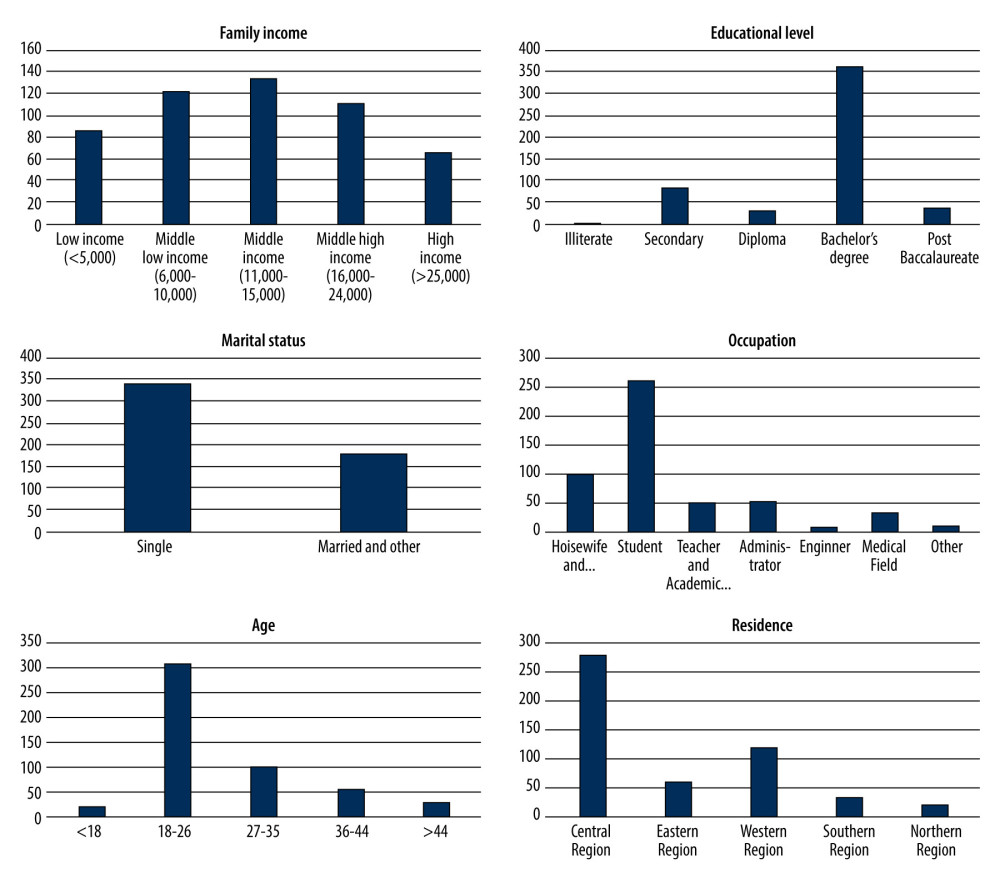11 April 2024: Clinical Research
Alexithymia and Quality of Life in Saudi Women with Polycystic Ovary Syndrome: A Community-Based Study
Leen E. AlturkiDOI: 10.12659/MSM.943594
Med Sci Monit 2024; 30:e943594
Abstract
BACKGROUND: The endocrine metabolic disorder polycystic ovary syndrome (PCOS) is quite common among women. Women with PCOS show a compromised health-related quality of life (HRQoL), impaired emotional well-being, and alexithymia, a neuropsychological phenomenon conceptualized as difficulty in recognizing and expressing one’s emotions. However, the relationship between alexithymia and HRQoL in women with PCOS is unclear. This study aimed to investigate the impact of alexithymia on HRQoL in women with PCOS in Saudi Arabia.
MATERIAL AND METHODS: This descriptive cross-sectional, community-based study enrolled 518 female patients with a diagnosis of PCOS from all age groups. The patients were surveyed via a self-administered questionnaire from December 2022 to January 2023. The survey encompassed sociodemographic data, the 20-item Toronto Alexithymia Scale (TAS-20), and HRQoL 15-dimensional scale (15D).
RESULTS: This study included 320 participants (61.8%) with alexithymia. A significant association was found between alexithymia and low HRQoL 15D scores in patients with PCOS. Specifically, scores on the TAS-20 subscales related to difficulty in identifying feelings and describing feelings were positively correlated with HRQoL (P=0.000). However, externally oriented thinking subscale scores were not positively correlated with HRQoL (P=0.44).
CONCLUSIONS: The presence of alexithymia is associated with poor HRQoL in women with PCOS, which is more pronounced among those who received a diagnosis ≥4 years ago. Alexithymia must be considered when assessing the HRQoL of patients with PCOS, considering the relatively high prevalence of alexithymia in these patients.
Keywords: Affective Symptoms, Quality of Life, Women's Health
Introduction
Individuals with alexithymia commonly display challenges in recognizing emotions, experience difficulties in feelings of excitement, and can have limitations in dreaming and imagination [1,2]. Alexithymia is prevalent among persons with depression, and its severity decreases as depression is alleviated. Consequently, alexithymia is a state-dependent phenomenon [1]. This condition is linked to many chronic diseases, including psoriasis, ankylosing spondylitis [3], fibromyalgia [4], Parkinson disease [5] and polycystic ovary syndrome (PCOS) [6].
PCOS is one of the most prevalent causes of infertility, with an incidence of 5% to 15% [7]. Women with PCOS have an increased prevalence of depressive episodes and anxiety symptoms [8]. Women experiencing infertility have a higher incidence of alexithymia than do women without infertility. Moreover, this incidence can be influenced by the variable degrees of stress in women with infertility. Hence, women with infertility and PCOS can exhibit variable degrees of alexithymia, compared with those without PCOS [9]. Additionally, PCOS has been shown to have a detrimental effect on health-related quality of life (HRQoL) scores. Specifically, declines in psychosocial well-being and sexual satisfaction are linked to physical symptoms of PCOS, such as weight gain, hirsutism, and acne [2]. PCOS is typically diagnosed according to the Rotterdam criteria, which includes the presence of 2 of 3 clinical features: chronic anovulation, clinical or biological hyperandrogenism, and polycystic ovary morphology, in the absence of any other pathology. Transvaginal ultrasound is used in the assessment of the polycystic ovary morphology since it provides accurate results. Furthermore, PCOS is managed by lifestyle modification for reduction of weight and diet control; hormonal therapy is used for improving menstrual abnormalities; and metformin is prescribed for women who have diabetes mellitus [10].
Although some investigators have identified factors correlated with HRQoL in patients with PCOS [5], little is known about how these factors are related to alexithymia. Therefore, this community-based study included 518 female patients with a diagnosis PCOS and aimed to evaluate alexithymia using the 20-item Toronto Alexithymia Scale (TAS-20) and the health-related HRQoL 15-dimensional scale (15D).
Material and Methods
ETHICS STATEMENT:
The study was approved by the Institutional Ethical Review Board of Majmaah University (approval no. HA-01-R-088). Written informed consent was obtained from the women with PCOS who participated in the study.
STUDY DESIGN:
This cross-sectional community-based study was conducted in Saudi Arabia from December 2022 to January 2023. The sample size was calculated as 207, using convenience (non-probability) sampling.
DATA COLLECTION:
Data were collected using electronic questionnaires distributed among female patients with PCOS. The diagnosis of PCOS was confirmed through questionnaires that indicated that PCOS was diagnosed by medical practitioners. A total of 1060 patients were approached. Of these, 542 were excluded. Finally, 518 patients were enrolled in the study. The inclusion criterion was women living in Saudi Arabia who had received a diagnosis of PCOS. The exclusion criteria were individuals with mental health disorders, history of other chronic illnesses, and those who did not speak English or Arabic.
The administered questionnaires focused on sociodemographic data, including age, occupation, educational level, residence, family income, and marital status, alexithymia, and QoL. Alexithymia was evaluated using the TAS-20 in both Arabic and English, depending on the patient’s native language. The TAS-20 is considered the most commonly used and well-validated method for assessing alexithymia [11]. Its reliability, both in terms of internal consistency and test-retest measures, and its validity in terms of convergent, discriminant, and concurrent measures, have been demonstrated to be strong. The TAS-20 is a self-report scale with 20 items scored using a 5-point Likert scale (1 for strongly disagree and 5 for strongly agree). The following dimensions of alexithymia were assessed: difficulty identifying feelings (DIF), difficulty describing feelings (DDF), and externally oriented thinking (EOT). Scores for these dimensions were added to obtain a total possible score of 95. The TAS-20 uses the following cutoff score values: ≤51=non-alexithymia, 52–60=possible alexithymia, and ≥61=alexithymia.
The HRQoL 15D measures mobility, vision, hearing, breathing, sleeping, eating, speech, elimination, usual activities, mental functioning, discomfort and symptoms, depression, distress, vitality, and sexual activity.
STATISTICAL ANALYSIS:
Data were analyzed using IBM SPSS Statistics version 26 (IBM Corp, Armonk, NY, USA). Continuous variables are presented as mean and standard deviation, while categorical variables are presented as numbers and percentages. The chi-square test was used to compare continuous and qualitative variables. Additionally, independent
Results
SOCIODEMOGRAPHIC CHARACTERISTICS OF PATIENTS PCOS:
The sociodemographic characteristics of the 518 patients who met the inclusion criteria are illustrated in Figure 1. The age categories ranged from less than 18 years to over 44 years. A total of 308 (59.5%) patients were in the 18–26 year category. Most patients (262 [50.6%]) were students. More than half (340 [65.8%]) were single, while 177 (34.2%) patients were either married, divorced, or widowed.
PREVALENCE OF ALEXITHYMIA:
The TAS-20 scores are presented in Table 1. Of 518 patients, 68 (13.1%) had no alexithymia, 320 (61.8%) had alexithymia, and 130 (25.1%) had possible alexithymia.
TAS-20, DIF, DDF, EOT, AND HRQOL 15D SCORES FOR EACH CATEGORY:
Descriptive statistics regarding demographics, TAS-20 scores, and HRQoL 15D scores are listed in Table 2. Regarding marital status, single patients had a significantly higher mean total TAS-20 score than those who were married, divorced, or widowed (64.6 vs 62.4; P<0.05). In addition, patients with lower family incomes had higher mean alexithymia scores (64.8; 95% CI 62.5–67.0) than those with higher incomes (61.8; 95% CI 59.1–64.5).
Patients in the age category of 27–35 years exhibited the highest mean HRQoL score (0.8; 95% CI 0.8–0.9), while participants aged 44 years and older showed the lowest mean score (0.8; 95% CI 0.8–0.9). Although a higher family income was associated with a higher HRQoL, this was not statistically significant. Geographical region, education level, occupational status, and marital status were also not significant predictors of HRQoL.
TIME SINCE PCOS DIAGNOSIS AND CORRESPONDING ALEXITHYMIA SCORES:
Regarding the time since PCOS diagnosis, 279 patients (54%) had received a diagnosis of PCOS 1 to 3 years before the study. The 140 patients (27%) with diagnosis 4 to 7 years prior to the study had the highest mean TAS-20 score (65.7). However, no significant difference was observed between the alexithymia scores of patients in the 3 categories for time since PCOS diagnosis, as shown in Table 3.
CORRELATION BETWEEN ALEXITHYMIA AND HRQOL 15D SCORES:
Table 4 shows the correlation between alexithymia and HRQoL in patients with PCOS. Among participants, the mean HRQoL 15D score of 320 participants (61.8%) with alexithymia was 0.8. In contrast, the mean score of 68 participants (13.1%) with no alexithymia was 0.9, signifying diminished HRQoL in the presence of alexithymia.
CORRELATION BETWEEN TAS-20 DIF, DDF, AND EOT AND HRQOL 15D SCORES:
As shown in Table 5, the TAS-20 DIF and DDF subscale scores were positively correlated with HRQoL 15D scores, whereas the EOT score was not positively correlated with HRQoL.
Discussion
The present study shows that 320 (61.8%) of 518 patients with PCOS had alexithymia. A significant association was found between alexithymia and low HRQoL in patients with PCOS. Furthermore, other studies have reported a significantly higher prevalence of abnormal HRQoL in patients with PCOS than in those without PCOS [12].
TAS-20 scores were associated with DIF, whereas the DDF score was associated with HRQoL (
The prevalence of alexithymia in the present study was higher than that reported in a previous study finding only 10% of the general population [2]. In addition, other studies have reported a lower percentage of alexithymia (26.9%) among medical students [3,4]. Furthermore, a study from 8 countries found that 28% of patients with psoriasis experience alexithymia [8]. Notably, the prevalence of alexithymia in patients with fibromyalgia ranges from 15% to 52% [13]. A case-control study conducted on 240 women with infertility (120 with PCOS and 120 without PCOS) in Iran using depression and TAS-20 scales showed that the mean total scores of alexithymia symptoms in women with PCOS were significantly higher than of those without PCOS [14]. Compared with previous studies involving other populations, the present study revealed a higher prevalence of alexithymia in patients with PCOS, which was shown to negatively affect their daily lives.
Factors influencing HRQoL in patients with PCOS have been identified [5], but the relationship between these factors and alexithymia remains unclear. Therefore, we aimed to examine the effects of alexithymia on HRQoL in patients with PCOS using a representative population survey. The study’s primary finding was the link between alexithymia and poorer HRQoL in women with PCOS.
Most patients in the study received a diagnosis of PCOS 1 to 3 years prior to the study, with those with diagnosis 4 to 7 years prior scoring having the highest scores on the TAS-20. Regarding the relationship between alexithymia scores and HRQoL, participants with alexithymia had lower HRQoL. Similarly, a study performed on the general population in Finland indicated that alexithymia is significantly linked to lower HRQoL. This association was more evident in the DIF subscale [15]. In the present study, both the DIF and DDF subscales showed positive correlations. Meanwhile, another Finnish study comparing the HRQoL 15D scores of groups with and without alexithymia reported lower scores for every dimension of the 15D scale in the alexithymia group [16,17]. Overall, our analysis showed a correlation between alexithymia and poor HRQoL, a finding that is consistent with previous studies reporting an association between alexithymia and poorer HRQoL in various medical conditions [1]. Our results suggest that the negative correlation between alexithymia and HRQoL is driven primarily by EOT. The results further reinforce the notion that HRQoL is affected by PCOS and alexithymia.
Our findings provide valuable information about the PCOS community, providing a unique contribution to the advancement of medical science that aims to enhance the condition, well-being, and QoL of patients with PCOS. In addition, our results have potential implications for Saudi healthcare, underlining the importance of evaluating the presence of alexithymia in patients with PCOS. Therefore, considering alexithymia when evaluating HRQoL in different population groups, especially in patients with PCOS, is crucial. Nonetheless, altering alexithymia as a personality trait can pose challenges. Therefore, enhancing caregivers’ understanding of the unique challenges they face can be beneficial in managing this medical issue.
This research can serve as a catalyst for future studies aiming to explore effective treatments for alexithymia and assess their efficacy. Having been the subject of basic research for 4 decades, alexithymia provides a rich foundation for an active exchange of ideas between practitioners and researchers, potentially paving the way for further investigations into clinical applications.
This study had some limitations. First, it did not include a control group. Second, data collection relied on questionnaires, posing potential challenges for patients with alexithymia in accurately assessing their deficiencies. Last, although questionnaires were distributed to different Saudi regions, the geographic distribution of the received responses was unequal.
Conclusions
The presence of alexithymia was found to be associated with poor HRQoL in women with PCOS, which is more pronounced among those who received a diagnosis of PCOS ≥4 years ago. Future research should examine the relationship between alexithymia and PCOS in considerable detail, using the framework of computational neuroscience as it applies to emotional awareness. This can contribute to a deeper understanding of the pathophysiological mechanism through which PCOS contributes to alexithymia.
Tables
Table 1. TAS-20 scores of participants with PCOS (N=518).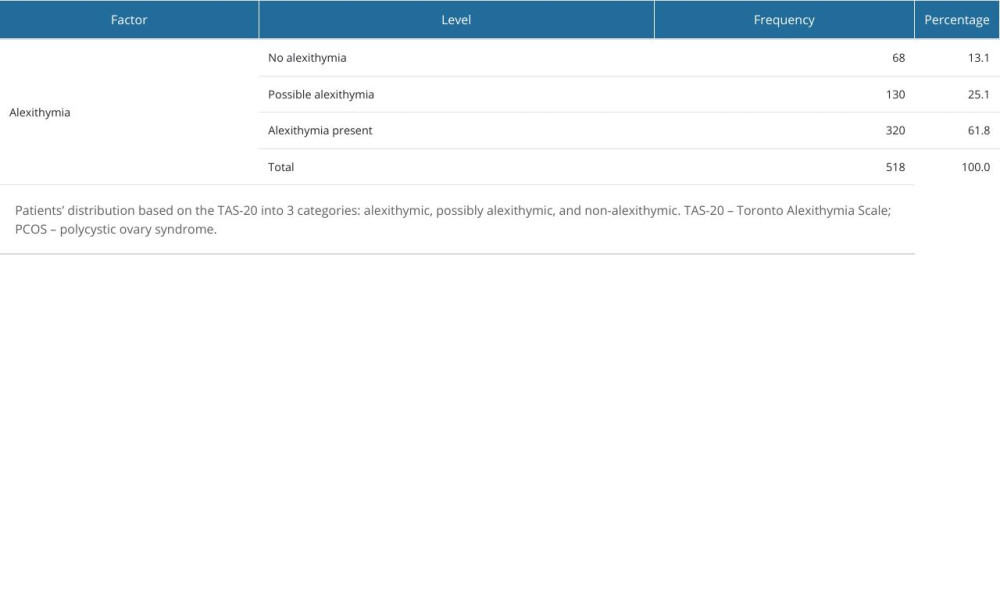 Table 2. TAS-20, DIF, DDF, EOT, and HRQoL 15D scores for each category.
Table 2. TAS-20, DIF, DDF, EOT, and HRQoL 15D scores for each category.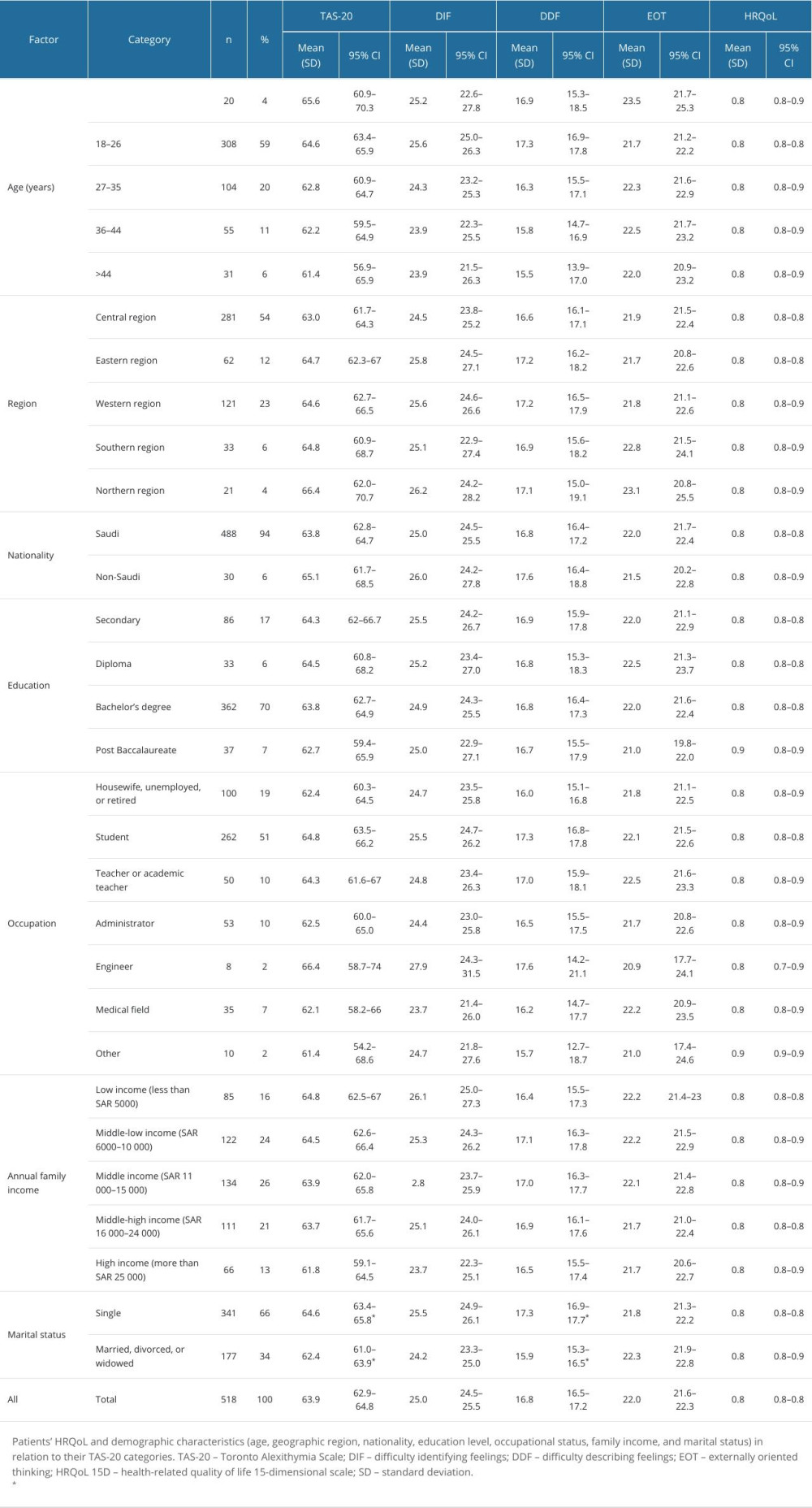 Table 3. Duration since PCOS diagnosis and corresponding alexithymia scores, categorized by TAS-20 scores.
Table 3. Duration since PCOS diagnosis and corresponding alexithymia scores, categorized by TAS-20 scores.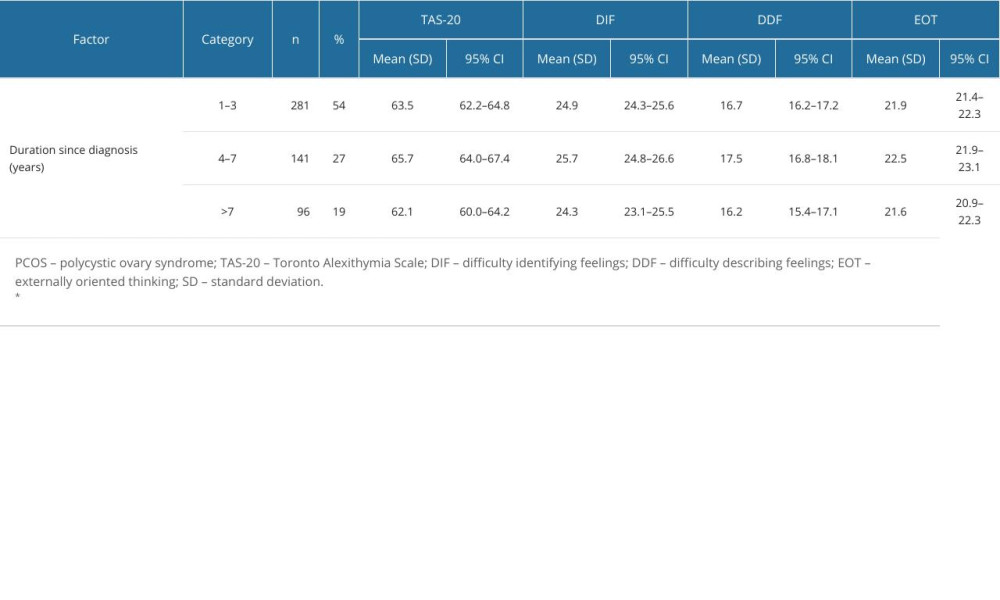 Table 4. Correlation between alexithymia and HRQoL 15D scores.
Table 4. Correlation between alexithymia and HRQoL 15D scores.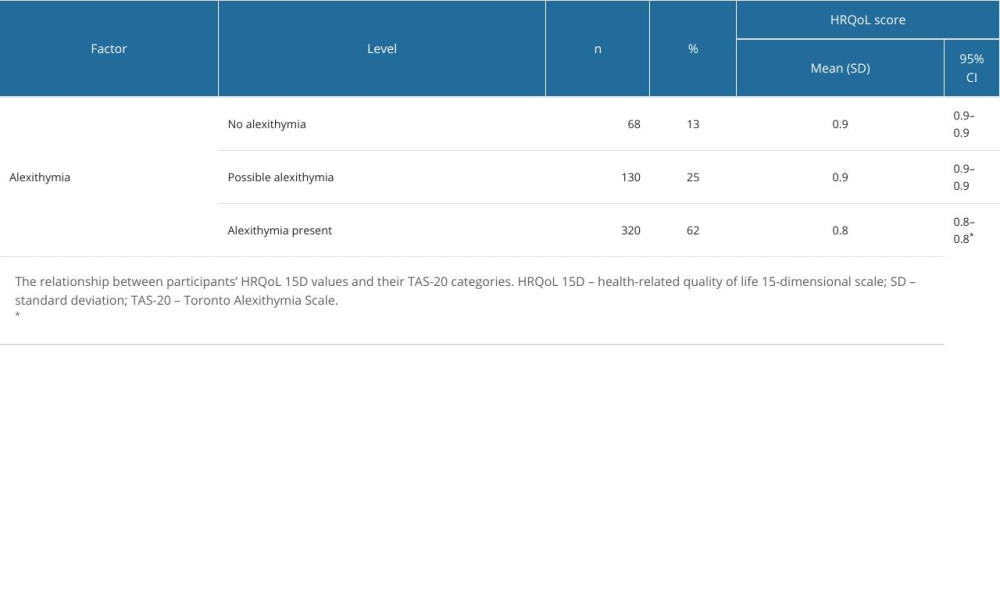 Table 5. Correlation between TAS-20 DIF, DDF, and EOT and HRQoL 15D scores.
Table 5. Correlation between TAS-20 DIF, DDF, and EOT and HRQoL 15D scores.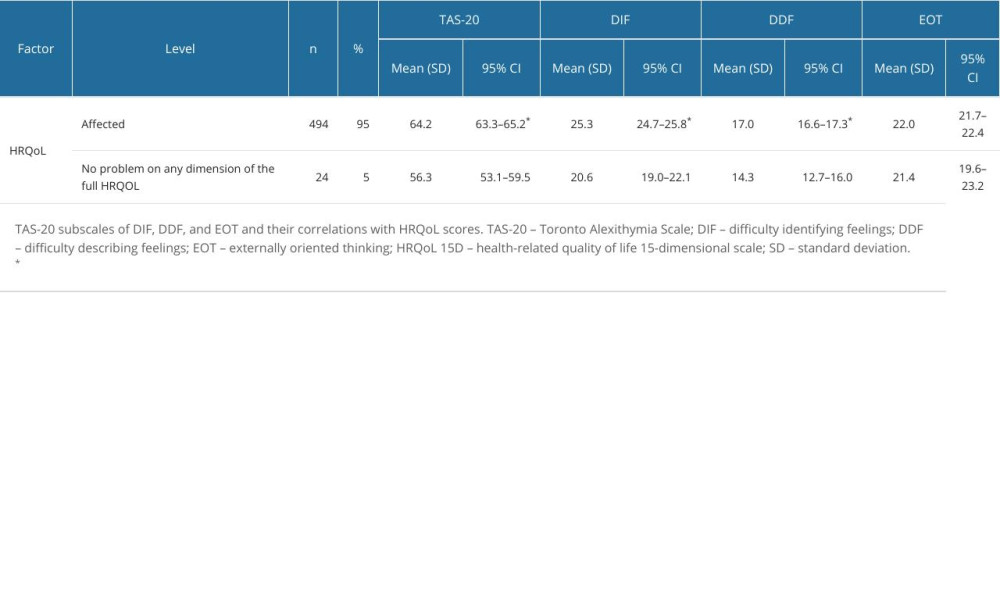
References
1. Hogeveen J, Grafman J, Alexithymia: Handb Clin Neurol, 2021; 183; 47-62
2. Ricciardi L, Demartini B, Fotopoulou A, Edwards MJ, Alexithymia in neurological disease: A review: J Neuropsychiatry Clin Neurosci, 2015; 27(3); 179-87
3. Aljaffer MA, Almadani AH, Alghamdi SA, Prevalence and associated factors of alexithymia among medical students: A cross-sectional study from Saudi Arabia: Neurosciences (Riyadh), 2022; 27(4); 257-62
4. Alzahrani SH, Coumaravelou S, Mahmoud I, Prevalence of alexithymia and associated factors among medical students at King Abdulaziz University: A cross-sectional study: Ann Saudi Med, 2020; 40(1); 55-62
5. Tesio V, Di Tella M, Ghiggia A, Alexithymia and depression affect quality of life in patients with chronic pain: A study on 205 patients with fibromyalgia: Front Psychol, 2018; 9; 442
6. Kinnaird E, Stewart C, Tchanturia K, Investigating alexithymia in autism: A systematic review and meta-analysis: Eur Psychiatry, 2019; 55; 80-89
7. Wang J, Wu D, Guo H, Li M, Hyperandrogenemia and insulin resistance: The chief culprit of polycystic ovary syndrome: Life Sci, 2019; 236; 116940
8. Cooney LG, Lee I, Sammel MD, Dokras A, High prevalence of moderate and severe depressive and anxiety symptoms in polycystic ovary syndrome: A systematic review and meta-analysis: Hum Reprod, 2017; 32(5); 1075-91
9. Aleisa MA, Abdullah NS, Alqahtani AAA, Association between alexithymia and depression among King Khalid University Medical students: An analytical cross-sectional study: Healthcare (Basel), 2022; 10(9); 1703
10. Rasquin LI, Anastasopoulou C, Mayrin JV, Polycystic ovarian disease: StatPearls, 2022, Treasure Island (FL), StatPearls Publishing
11. Asdaq SMB, Jomah S, Hasan R, Impact of polycystic ovary syndrome on eating behavior, depression and health related quality of life: A cross-sectional study in Riyadh: Saudi J Biol Sci, 2020; 27(12); 3342-47
12. Bagby RM, Parker JDA, Taylor GJ, Twenty-five years with the 20-item Toronto alexithymia scale: J Psychosom Res, 2020; 131; 109940
13. Tang FY, Xiong Q, Gan T, The prevalence of alexithymia in psoriasis: A systematic review and meta-analysis: J Psychosom Res, 2022; 161; 111017
14. Basirat Z, Faramarzi M, Esmaelzadeh S, Stress, depression, sexual function, and alexithymia in infertile females with and without polycystic ovary syndrome: A case-control study: Int J Fertil Steril, 2019; 13(3); 203-8
15. Maes F, Sabbe BGAlexithymia in fibromyalgia: prevalence: Tijdschr Psychiatr, 2014; 56(12); 798-806 [in Dutch]
16. Mattila AK, Saarni SI, Salminen JK, Alexithymia and health-related quality of life in a general population: Psychosomatics, 2009; 50(1); 59-68
17. Mattila AK, Saarni SI, Alanen E, Health-related quality-of-life profiles in nonalexithymic and alexithymic subjects from general population: J Psychosom Res, 2010; 68(3); 279-83
Tables
 Table 1. TAS-20 scores of participants with PCOS (N=518).
Table 1. TAS-20 scores of participants with PCOS (N=518). Table 2. TAS-20, DIF, DDF, EOT, and HRQoL 15D scores for each category.
Table 2. TAS-20, DIF, DDF, EOT, and HRQoL 15D scores for each category. Table 3. Duration since PCOS diagnosis and corresponding alexithymia scores, categorized by TAS-20 scores.
Table 3. Duration since PCOS diagnosis and corresponding alexithymia scores, categorized by TAS-20 scores. Table 4. Correlation between alexithymia and HRQoL 15D scores.
Table 4. Correlation between alexithymia and HRQoL 15D scores. Table 5. Correlation between TAS-20 DIF, DDF, and EOT and HRQoL 15D scores.
Table 5. Correlation between TAS-20 DIF, DDF, and EOT and HRQoL 15D scores. Table 1. TAS-20 scores of participants with PCOS (N=518).
Table 1. TAS-20 scores of participants with PCOS (N=518). Table 2. TAS-20, DIF, DDF, EOT, and HRQoL 15D scores for each category.
Table 2. TAS-20, DIF, DDF, EOT, and HRQoL 15D scores for each category. Table 3. Duration since PCOS diagnosis and corresponding alexithymia scores, categorized by TAS-20 scores.
Table 3. Duration since PCOS diagnosis and corresponding alexithymia scores, categorized by TAS-20 scores. Table 4. Correlation between alexithymia and HRQoL 15D scores.
Table 4. Correlation between alexithymia and HRQoL 15D scores. Table 5. Correlation between TAS-20 DIF, DDF, and EOT and HRQoL 15D scores.
Table 5. Correlation between TAS-20 DIF, DDF, and EOT and HRQoL 15D scores. In Press
08 Mar 2024 : Laboratory Research
Evaluation of Retentive Strength of 50 Endodontically-Treated Single-Rooted Mandibular Second Premolars Res...Med Sci Monit In Press; DOI: 10.12659/MSM.944110
11 Mar 2024 : Clinical Research
Comparison of Effects of Sugammadex and Neostigmine on Postoperative Neuromuscular Blockade Recovery in Pat...Med Sci Monit In Press; DOI: 10.12659/MSM.942773
12 Mar 2024 : Clinical Research
Comparing Neuromuscular Blockade Measurement Between Upper Arm (TOF Cuff®) and Eyelid (TOF Scan®) Using Miv...Med Sci Monit In Press; DOI: 10.12659/MSM.943630
11 Mar 2024 : Clinical Research
Enhancement of Frozen-Thawed Human Sperm Quality with Zinc as a Cryoprotective AdditiveMed Sci Monit In Press; DOI: 10.12659/MSM.942946
Most Viewed Current Articles
17 Jan 2024 : Review article
Vaccination Guidelines for Pregnant Women: Addressing COVID-19 and the Omicron VariantDOI :10.12659/MSM.942799
Med Sci Monit 2024; 30:e942799
14 Dec 2022 : Clinical Research
Prevalence and Variability of Allergen-Specific Immunoglobulin E in Patients with Elevated Tryptase LevelsDOI :10.12659/MSM.937990
Med Sci Monit 2022; 28:e937990
16 May 2023 : Clinical Research
Electrophysiological Testing for an Auditory Processing Disorder and Reading Performance in 54 School Stude...DOI :10.12659/MSM.940387
Med Sci Monit 2023; 29:e940387
01 Jan 2022 : Editorial
Editorial: Current Status of Oral Antiviral Drug Treatments for SARS-CoV-2 Infection in Non-Hospitalized Pa...DOI :10.12659/MSM.935952
Med Sci Monit 2022; 28:e935952









